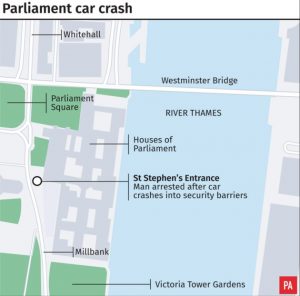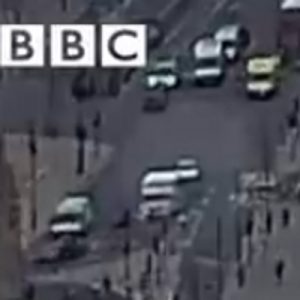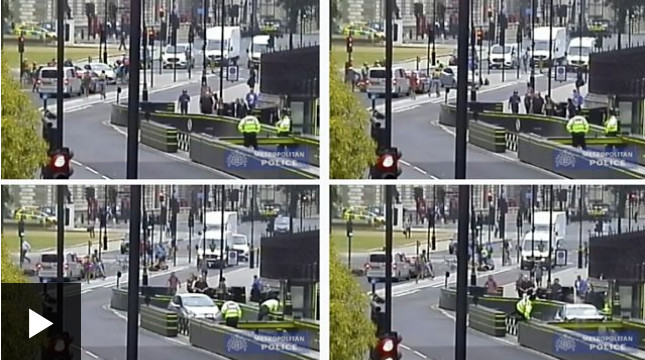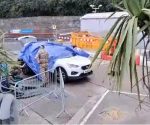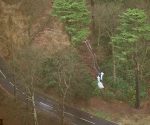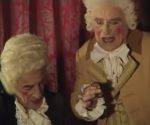The Westminster car crash deemed a terror attack: Britain’s Finest have their dopiest escapade yet
Salih Khater (Salihk Hater) was the driver who ploughed a Ford Fiesta into a barrier outside of Parliament at just after half past seven of the hour, this past Tuesday gone. However, he wasn’t the only one making crazy manoeuvres on the streets of Westminster amongst all the skittled cyclists as they headed to work. The driver of the “mystery van” also cut across a reservation dividing two roads – and he wasn’t the only other “civilian” doing something naughty. In fact, there was so much going on in a matter of a minute or so of footage captured by the BBC (from the same equipment that captured the Westminster Bridge incident in 2017, no doubt), that altogether it started to scream “false flag attack”.
Naturally, the fun and games have not been demonstrated to the public in all their glorious fullness; only the suspicious meanderings of the “mystery van” have achieved examination – and exoneration. Evidently, this vehicle made itself so conspicuous as to intrude upon whatever simple narrative was going to serve as an explanation for Khater’s stunt performance, and as such needed to be discussed by official parties out in the open in order to encourage the public to rationalise it as being perfectly normal. Reader, take note: a new record for the quickest time after an incident where the Establishment acts to counter a conspiracy theory. Indeed, the “mystery van” was such a sore thumb sticking out that it was raised by reporters at a press briefing by the head of counter-terrorism at the Metropolitan Police, Neil Basu (the latter-day Inspector Lestrade of Salisbury debacle fame) so that he could refer to it, and sweep it out of anyone’s further notice: “No, I’ve heard that this morning. There wasn’t a police car in pursuit of the vehicle.”
This information comes from the Daily Mail, the only “big” corporate-media that gives room for the story on internet pages one doesn’t have to pay for (a reference to the Telegraph). The Mail’s treatment will be related in due course – it’s quite obvious by the time one reads to the end of it what the objective is.
To appreciate the array of odd behaviour on display in the BBC footage of the so-called terror attack outside Parliament on the 14th August, one needs to understand the lay of the roads thereabouts. The A3212 runs parallel to the Thames with Parliament on its left, and the Square on its right. At the corner of Parliament Square, there is a choice to bend around to the right to travel perpendicularly with the river along the southern edge of the garden area, or to tend to the left and continue, eventually, to Millbank. It is off this south-heading section of the A3212 that there is a slip road leading to the St Stephens entrance of the Westminster Palace – for authorised vehicles, of course. Khater found himself in a barrier placed across the road to stop those who aren’t authorised. This south-to-north section of the A3212 merges into the western-travelling traffic after the right-hand bend (abovementioned), so essentially there are three pieces of road at the south-east corner of Parliament Square that are separated from each other by central reservations. The arrangement is plain to see on the map below:
As far as the main incident goes – that is, the erratic journey of the silver Ford Fiesta that everyone is supposed to know about – it starts after Khater has already entered the bend. For pictorial assistance to understanding events, please refer to the “image array” – basically a post containing all the images, and more, mentioned in this text – at the FBEL page here. Moments later, an ambulance on a call (its lights flashing) that has weaved from the very left-hand side of the road into the very right-hand side, speeds past Khater, who turns, as if triggered to do it, sharply onto the reservation that separates the bend and the south-to-north section of the A3212. Luckily (by design, some might say) traffic lights have stopped oncoming vehicles so that Khater can drive the wrong way along a one-way road without coming to any harm, and over the reservation onto the A3212 going south. He then swerves onto the slip road – and the rest is history.
By the way – some cyclists waiting on the reservations to cross got knocked over.
So much for the main plot. In the background behind the Fiat is a silver van with its lights on (Fig. 1). This is the “mystery van”, and it probably starts to veer to the left from its starting position on the right hand side of the road when the ambulance gets in between it and the Fiesta (Fig.2). In doing this, the “mystery van” starts to cut up another vehicle – what we will call the “paddy wagon” for reasons about to be revealed. These two vehicles, and a third to their right, proceed to come to a halt – so presumably they are all stopped by traffic lights (Fig. 4). The “mystery van” is still waiting by the time the Fiesta has crossed the two central reservations in the junction complex at the south-east corner of Parliament Square (Fig. 5), but finally moves – technically jumping the lights – to cut in front of the “paddy wagon” just as the Fiesta is about to enter the slip road to the St Stephens entrance (Fig. 6). Moreover, the “mystery van” then itself cuts over central reservation to follow the Fiesta. Note – it does this before the Fiesta crashes, so it is not motivated by good will to a fellow driver whose crash might have appeared to have been an accident.
Indeed, the person driving the “mystery van” is not a typical vehicle operator on the streets of London because he shows too much interest in a car that is about to commit a “terror attack”. Moreover, the driver of the “mystery van” gets stuck behind another vehicle, a white van (seen manoeuvring into position in Fig. 3), and cannot possibly see that the Fiesta has crashed, but is still in a tremendous hurry to keep up with it. This is demonstrated by the way it continuously showed its right-hand headlight along the side of the white van, which was travelling sedately, as if it was always looking for a way to pass even by mounting the kerb. In fact, the driver of the “mystery van” did put more than a wheel over the line to do this in the end so that it could stop in front of the white van near the scene of the crash (Fig. 7). Without a doubt, someone from the police or the security services has been caught tailing a “terror suspect” immediately prior to the attack he was about to commit.
The Establishment has dealt with this officially and unofficially. Basu of the Met Police denied the police tail, as we have seen, but also made it be known that Mi5 had never heard of Khater. The distancing from the suspect is therefore complete in a way that rarely happens in such a case. Unofficially, at least one ex-policeman and Scotland Yard detective, David Videcette, has had his “expert” opinion telegraphed for public consumption. The following is from the Mail article linked to above:
Experts, including retired Met detective David Videcette, who worked in counter-terrorism on 7/7, believes the Transit [“mystery van”] may have had a police officer behind the wheel.
But it could [have] be[en] (sic) on a different job and noticed the strange behaviour of the driver.
He said: ‘There appears to be silver Transit van following the Fiesta, the van has its lights on. The silver van carries on following the Fiesta wherever it goes.
‘The consensus between those of us who are ex-Police, is that this is likely an unmarked police vehicle, who spotted the Fiesta acting strangely before it rammed the barrier.
…He added: ‘Perhaps the Fiesta was just on hostile reconnaissance, never intended on an attack today, but then realised he’d been spotted by someone, and hence carried out the attack in a small vehicle?’
The question that leaps out to the reader is how did Khater know that the police were operating an unmarked vehicle? He would only know if he was an insider on the operation. From the perspective of an Establishment voice whose experience of state crime includes involvement in the 7/7 bombings, there are no patsies who are insiders on the operation. Therefore, Videcette’s opinion cancels itself into nothing. His contribution is merely to encourage people not to think too much.
The author’s opinion is this: the “mystery van” interjected when the driver saw the white van following the Fiesta – this is why it was in such a hurry to get past and in front of what was very likely a civilian vehicle getting itself into a position, by freak chance, that it shouldn’t have been in. Fig. 11 of the image array shows the white van turned back into the northward traffic, and the “mystery van” has effectively blocked the road. This would imply that the “mystery van” was part of a convoy to get the Fiesta to the right place at the right time – and that convoy could well have involved a marked police vehicle†. It is quite devastating stuff for whatever is left of the reputation of the state crime enablers formerly known as UK police forces.‡
The reader must understand that study of such events has taught the author a fact: there is not an arrangement that is ever too complex to rule it out from being employed by Government to perpetrate its state crime. And in this event, it is quite possible that the traffic lights on the junction complex coming from the south into Parliament Square were set to red at an appointed time, and then stayed red for an interminable time (and undeterminable time as far as we are concerned) for the purposes of the operation. Fig.12 of the image array shows a line of traffic coming from the south that has, at its head, the same vehicles that were waiting there when the incident started. For whatever other reason there was for closing down the flow of traffic at that point by traffic lights, this much we do know – it allowed speedy access for medical assistance to attend to all those unlucky cyclists. The reader might be astonished to learn that an ambulance arrived on the scene coming the wrong way up this road 39 seconds after the Fiesta crashed into that barrier (Fig. 10).
The south-to-north road into the junction complex was also the scene of its own odd behaviour involving what we are calling the “three-point-turn” car, and its passenger, who disembarked moments after the Fiesta crashed (see Figs. 13-19). This man runs across all the roads to stand by yards away from the Fiesta, where he appears to signal with a raised hand. This is extraordinary, as there are also police present at the scene, amongst them, the ones famously leaping out of the way of the crashing vehicle (the same ones who may yet be decorated for bravery, by all accounts). And yet, this character is permitted to stand by the vehicle belonging to the suspect in a crime unmolested. Not only that, the “three-point-turn” car starts to manoeuvre, in the manner described by the appellation given to it, just as soon as its passenger starts crossing the roads. Eventually it is turned so that it can drive across the central reservation, and down into the crash scene. If the reader consults Fig. 11 of the image array, this car is very likely the one that is seen parked next to the “mystery van”. Again, the occupants of this vehicle have too much interest in the Fiesta, and act with too much authority for them to be well meaning passers-by.
While this case is already possibly the dopiest false flag attack that ever took place in the history of the world, the floundering British Authorities are not through being incompetent yet. The police appear to be briefing the corporate-media, who is telling its audience that Khater is not playing ball. Apparently, he was in London to collect a Sudanese visa – that’s his story and he appears to be sticking to it (police have applied for more time for questioning). Does it indicate a patsy who figured it out a la James Earl Ray? Well, there’s a lot more can happen before we should start to speculate. Suffice it to say (and this is the author’s opinion) they might not even be able to get him on a count of attempted murder, let alone terrorism.
† Here’s something very interesting. It appears that there is an attempt to explain the “paddy wagon” away as an ambulance. The Wikipedia entry for the incident says:
An ambulance immediately behind the Ford stopped and gave assistance to the injured.
The source of this assertion come from a Telegraph article:
[Basu] added the attacker was not been pursued by police before he struck the entrance to the Palace of Westminster and that the blue lights seen behind him in footage of the incident were those of an ambulance coincidentally answering a separate emergency call.
Basu is talking about the ambulance that sped past the Fiesta. There was no ambulance immediately behind the Fiesta to give assistance. Below is an image of the “paddy wagon” (at the centre, in the front) and the weaving ambulance (on the right as the viewer looks at it) together at the top of the shot. The “paddy wagon” clearly does not have the same NHS yellow-green hue.
The author is of the opinion that an effort to misrepresent the nature of the one vehicle behind the Fiesta that did actually stop is evidence that it was a police vehicle after all.
‡ Update 17/08/18: The following is from the Evening Standard, written, it says, by a man named Justin Davenport (because it is about time that names started to be noted in connection with journalism to aid and abet State Crime). What it constitutes is an attempt to explain the “mystery van” – now white in colour – as driven by a sort of have-a-go hero. The author’s criticism has been added in brackets, and by emphasis in bold.
A mystery white van seen pursuing the alleged terrorist who drove into cyclists outside the Houses of Parliament was a member of the public trying to stop the attack, it emerged today. [Passing off unsubstantiated claims as fact and relying on an appeal to authority].
The unknown male driver of the Ford Transit van spotted suspect Salih Khater’s car veering into the security lane and immediately changed direction to give pursuit. [The male driver cannot be unknown if security services then retail a yarn about his adventures from his perspective. Rather, this civilian has been invented].
He raced after the suspect but became stuck behind another vehicle as Khater’s Ford Fiesta smashed into a security barrier. [This confirms that the Evening Standard is claiming that the “mystery van” was driven by a well-meaning civilian].
At first there was speculation that the mystery van was a police surveillance team who were secretly following Khater. [Basically the “copper on another job” fable didn’t cut the mustard].
However security sources confirmed that the driver was a member of the public who wanted to help. [The appeal to authority; it must be true because some unaccountable shadowy figures insist upon it].
A source said: “He stopped when he saw the car crash into the barriers. He wanted to help but when he saw the armed police arrive so quickly he realised there was little he could do.” [A source invented. In fact, the tale might just as well be a creation of the article’s writer, Davenport].
Of course, this information, which won’t name the driver despite his having made himself known to “security services”, apparently, to reveal his intentions, and which comes from an unnamed source from organisations that cannot be trusted, will appear highly unreliable – and a bit stupid – to the few of us who can think. However, the magic does work on the Muggles, and there are many, many more of them.
‡ Update, 18/07/19:
In the sort of high-quality CCTV footage that, in this type of incident, only gets released much later and typically at the time of a trial, the “paddy wagon” is actually shown as a plain white vehicle. That it wasn’t, after all, a marked police vehicle does not affect the damage done to this operation caused by the presence and behaviour of the “mystery van” – which can bee seen in the botton row of the image array below moving from (its) left to right befind the white van in its effort to pass.




